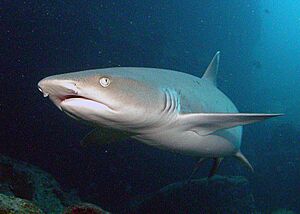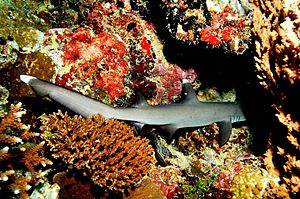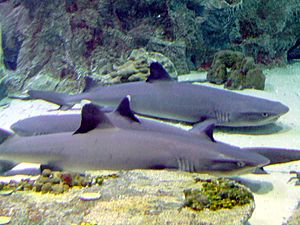Whitetip reef shark facts for kids
Quick facts for kids Whitetip reef shark |
|
|---|---|
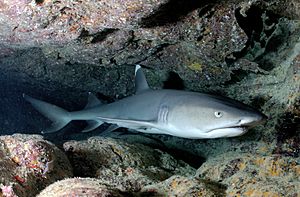 |
|
| Conservation status | |
| Scientific classification | |
| Kingdom: | |
| Phylum: | |
| Class: | |
| Subclass: | |
| Order: | |
| Family: | |
| Genus: |
Triaenodon
|
| Species: |
T. Obesus
|
| Binomial name | |
| Triaenodon Obesus |
|
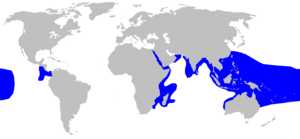 |
|
| Range of Whitetip reef shark | |
The Whitetip reef shark (Triaenodon obesus) is a type of requiem shark. It is the only shark in its special group, or genus. This shark gets its name from the white tips on its first dorsal fin (the fin on its back) and its caudal fin (tail fin).
This shark has a slim body and a short, wide head. Its snout is blunt and flat, and its eyes are oval-shaped. The shark's body is usually dark grey to brown, with a white underside. Whitetip reef sharks live all over the Indo-Pacific region. They are often found near coral reefs. You can also spot them over sandy areas, in lagoons, and near deep drop-offs.
Whitetip reef sharks are viviparous, which means they give birth to live young. After being pregnant for up to 12 months, a female shark can have 1 to 5 pups. The IUCN currently lists the whitetip reef shark as Near Threatened. This means it could become endangered in the future.
Contents
What Does the Whitetip Reef Shark Look Like?
The whitetip reef shark has a slender body and a wide, short head. Its snout is flat and blunt. It has large flaps of skin right in front of its nostrils. The eyes are small and oval, with pupils that look like vertical slits.
Its mouth slants downwards, and it has visible brow ridges. These features make the shark look like it has a "disgusted" expression! The first dorsal fin is located far back, behind its pectoral fins (the fins on its sides). The second dorsal fin is big, but still smaller than the first one. Its pectoral fins are wide and shaped like triangles. The anal fin (underneath the tail) is about the same size as the second dorsal fin. This shark does not have a ridge between its two dorsal fins.
The whitetip reef shark is named for the white tips on its first dorsal fin and the upper part of its caudal fin (tail). Its body is dark grey to brown, and its belly is white. Sometimes, you might see small dark spots all over its body. Other fins might also have white tips, but not always.
People sometimes confuse the whitetip reef shark with the Silvertip shark. They look similar, but the silvertip shark is much heavier. It also has a larger first dorsal fin and a much smaller second dorsal fin. Plus, the silvertip shark's tail fin has a white line along its edge, not just white tips.
This shark is quite small. It can grow up to almost 7 feet (2.1 meters) long. However, most whitetip reef sharks are usually less than 5.2 feet (1.6 meters) long. Male sharks become adults when they are about 3.4 feet (1.04 meters) long. They usually grow up to 5.5 feet (1.7 meters). Females become adults when they are 3.4 to 3.6 feet (1.04 to 1.1 meters) long. They can grow to at least 5.2 feet (1.6 meters). The heaviest whitetip reef sharks weigh about 18 kg (40 pounds).
Where Do Whitetip Reef Sharks Live?
The whitetip reef shark lives in many places across the Indo-Pacific region. In the Indian Ocean, you can find them from northern KwaZulu-Natal, South Africa, all the way to the Red Sea and India. This includes islands like Madagascar, Mauritius, and the Seychelles.
In the western and central Pacific Ocean, they live off southern China, Taiwan, and the Ryukyu Islands. They are also found in the Philippines, Southeast Asia, and Indonesia, down to northern Australia. You can also see them around many islands in Melanesia, Micronesia, and Polynesia, reaching as far as Hawaii and the Pitcairn Islands. In the eastern Pacific, they are found from Costa Rica to Panama, and near the Galápagos Islands.
Whitetip reef sharks mostly live near coral reefs. But they also swim over sandy areas, in lagoons, and near deep drop-offs. They like very clear water and usually stay close to the bottom. These sharks are most common at depths between 8 and 40 meters (26 to 130 feet). Sometimes, they might go into water less than 1 meter (3 feet) deep. One whitetip reef shark was even caught from a depth of 330 meters (1,083 feet) in the Ryukyu Islands!
How Do Whitetip Reef Sharks Behave?
You can often see whitetip reef sharks swimming in the clear waters around coral reefs. They have been found at depths up to 1,083 feet (330 meters). This species rarely swims to the surface. They can stay still on the bottom for a long time.
During the day, whitetip reef sharks often gather in large groups inside caves. Sometimes, they look like a pile of logs stacked up! The same sharks often return to the same cave for long periods. They only change their resting spot sometimes. Whitetip reef sharks are most active at night.
Feeding Habits
At night, the whitetip reef shark becomes very active. It searches for food along the ocean bottom. When a shark finds prey, it chases it into a small cave or crack, trapping it. The shark's slim body, blunt snout, and tough skin help it hunt well in these tight spaces.
It mainly eats bony fish, such as eels, squirrelfish, snappers, damselfish, parrotfish, surgeonfish, and triggerfish. It also enjoys eating octopuses, crabs, and lobsters.
Reproduction and Life Cycle
Whitetip reef sharks are viviparous, meaning they give birth to live young. After a gestation period (pregnancy) that can last about 12 months, the female shark gives birth to 1 to 5 pups. These baby sharks are usually 52 to 60 cm (20 to 24 inches) long.
When they mate, 1 to 11 male sharks might follow a female. One male will gently nip the female's gill area. If the female accepts him, the male will hold one of her pectoral fins in his mouth and mate with her. Whitetip reef sharks become adults around 8 years old. They can live up to a maximum age of 25 years.
How Do Humans Interact with Whitetip Reef Sharks?
People fish for whitetip reef sharks in the waters off Pakistan, India, Sri Lanka, and Madagascar. It is thought that they are also fished in other areas, but there isn't much information about it. The shark's meat and liver are sold for people to eat. However, the liver has been reported to be toxic.
Even though this shark is found in many places, its home is limited. It also has a small number of pups and takes a long time to grow up. This means the whitetip reef shark could become more threatened by too much fishing.
This shark is usually quite harmless to humans. It has a calm nature and small teeth. It avoids getting too close to people. If swimmers or divers approach, it usually swims away. Since whitetip reef sharks are often attracted to food, divers have even been able to hand-feed them. However, sometimes a shark might get too excited if there is spearfishing or bait around. In these cases, it might bite a diver. This shark is also known to bite if it feels bothered or threatened.
How Are Whitetip Reef Sharks Protected?
The whitetip reef shark is found in many places and is quite common. There are no specific laws against fishing this species. The whitetip reef shark project in Hawaii is studying this shark's life. They are looking at how it lives, where it moves, and its home range. They hope this research will help manage shark populations in the future.
The Food and Agriculture Organisation of the United Nations (FAO) has been working on a plan to protect sharks. It's called the International Plan of Action for the Conservation and Management of Sharks (IPOA-SHARKS). However, the oceans where the whitetip reef shark lives are huge. It is also hard to enforce laws in many areas. This makes protecting this shark very difficult. The IUCN currently lists the whitetip reef shark as Near Threatened.
Images for kids
See also
 In Spanish: Tiburón de arrecife de punta blanca para niños
In Spanish: Tiburón de arrecife de punta blanca para niños



